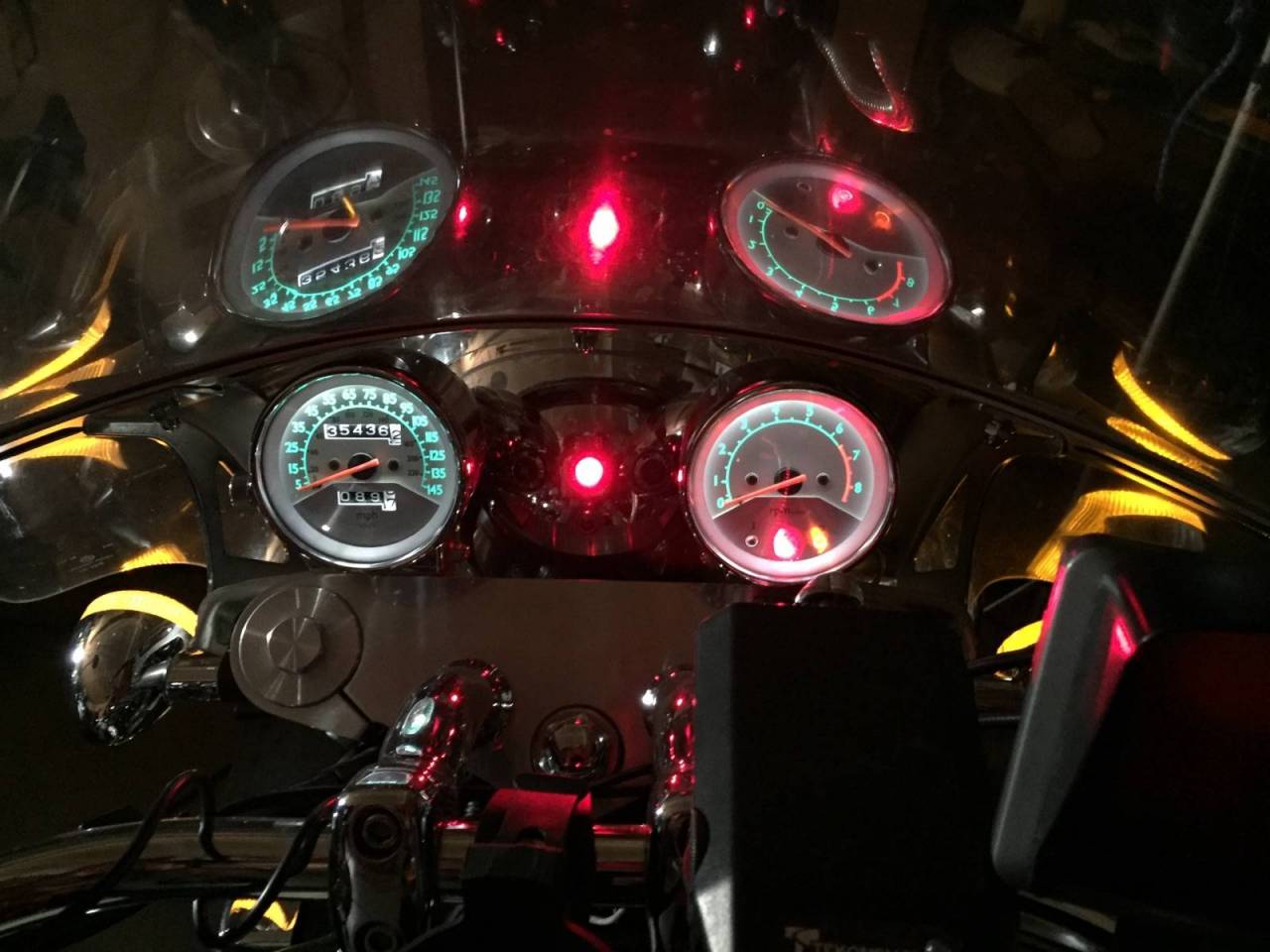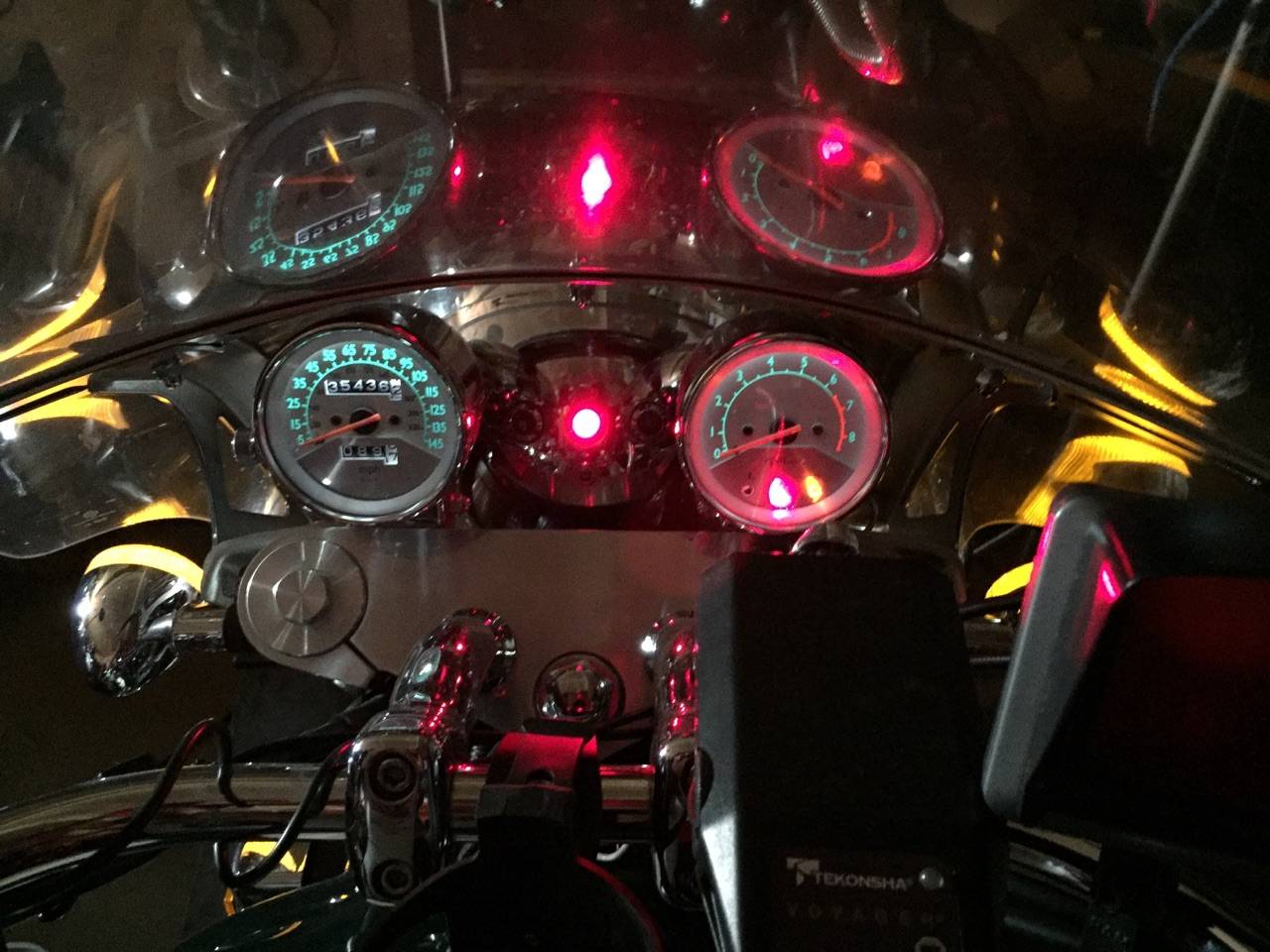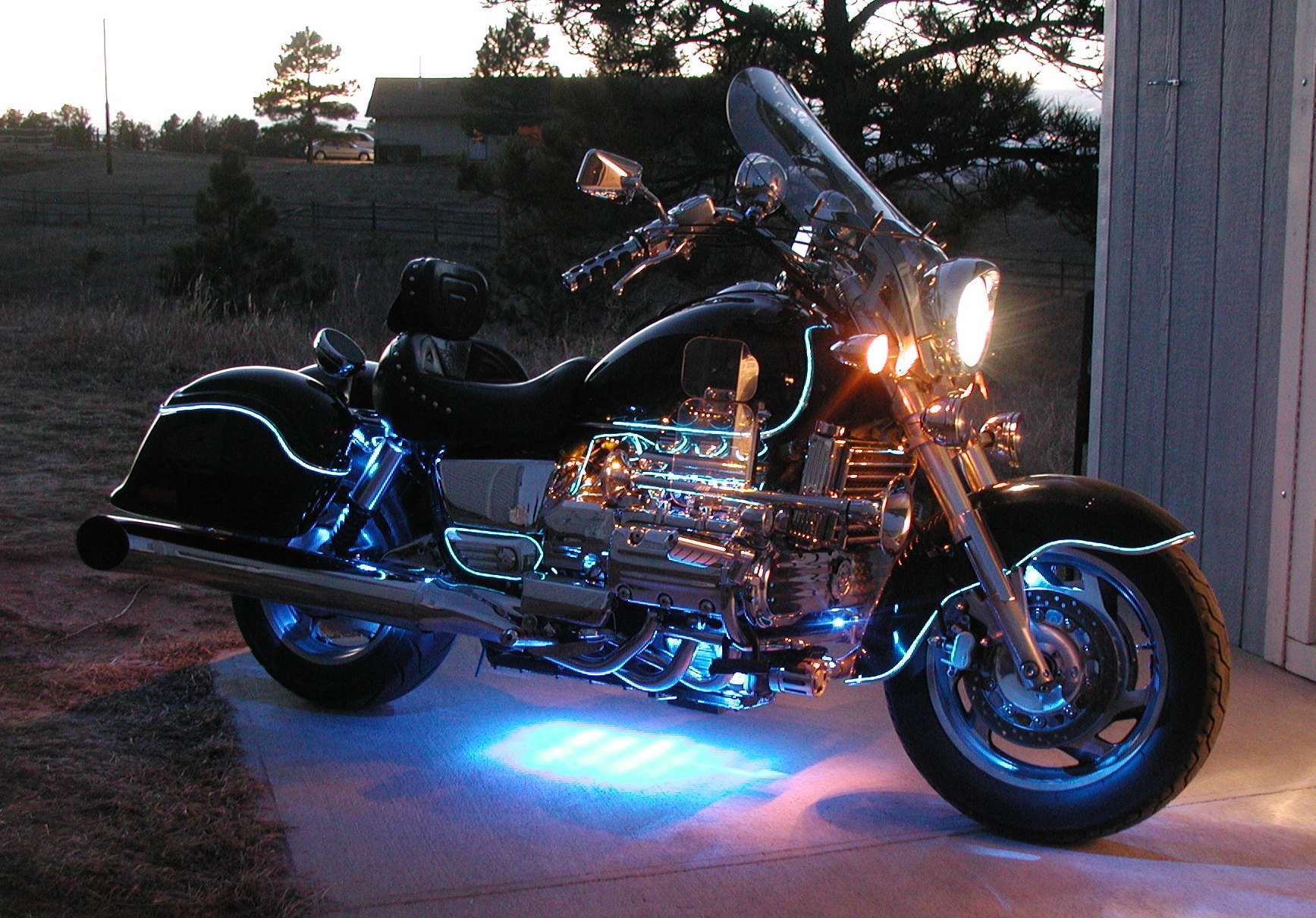|
3W-lonerider
|
 |
« on: February 18, 2019, 12:40:48 PM » |
|
for those that have switched their dash lights in the interstate dash to led and went with another color other than a clear bulb.
were you happy with the red or the blue.
i have bulbs ordered, they were cheap threw superbright leds.
but i ordered clear, blue and red. just figured i'd get others opinions.
|
|
|
|
|
 Logged
Logged
|
|
|
|
|
Bambam650
|
 |
« Reply #1 on: February 18, 2019, 02:41:06 PM » |
|
I did the same thing a few years ago and ended up going with the white bulbs. The colored bulbs wash out certain portions of the dial depending on the specific color and just aren't as visible at night.
|
|
|
|
|
 Logged
Logged
|
1997 Standard (Black) original owner, bought new in August 1996
|
|
|
MarkT
Member
    
Posts: 5196
VRCC #437 "Form follows Function"
Colorado Front Range - elevation 2.005 km

|
 |
« Reply #2 on: February 19, 2019, 12:13:37 PM » |
|
Exactly. I tested all the colors with std/Tourer instruments as well. Same thing - side-by-side test the white bulbs are best; the others make numerals and/or dash marks or needles disappear. On mine, I added a pot to dial the brightness up or down to off like a car's dash.
|
|
|
|
|
 Logged
Logged
|
|
|
|
|
Bambam650
|
 |
« Reply #3 on: February 19, 2019, 12:56:16 PM » |
|
Excellent idea. That way you can just replace the stock bulbs with the brightest LED's you can find.
PS - I'm putting this one on my to do list.
|
|
|
|
« Last Edit: February 19, 2019, 01:11:52 PM by Bambam650 »
|
 Logged
Logged
|
1997 Standard (Black) original owner, bought new in August 1996
|
|
|
|
Bambam650
|
 |
« Reply #4 on: February 19, 2019, 02:44:09 PM » |
|
Mark........can you please provide the specs on the dimmer you used.
|
|
|
|
|
 Logged
Logged
|
1997 Standard (Black) original owner, bought new in August 1996
|
|
|
MarkT
Member
    
Posts: 5196
VRCC #437 "Form follows Function"
Colorado Front Range - elevation 2.005 km

|
 |
« Reply #5 on: February 19, 2019, 03:10:40 PM » |
|
Sorry can't say I just grabbed a pot from my electronics drawer and gave it the smoke test. Didn't measure it's range and accessing the prongs now w/o removing it would be difficult at best. I suspect many low range rotary analog pots would work. Like a 1 watt or less. Maybe measure the power rating of your LEDs - or use their specs - and get a pot to match. See 3rd paragraph following for picking the ohms rating. Please note that the power rating of a potentiometer is for the entire end-to-end resistance. If you use (as is typical) a fraction of the potentiometer's end-to-end resistance, the power is reduced accordingly. The easiest way to think about it is that there is a maximum current through the pot. If you have a 1W 100 ohm potentiometer, the max. current is 100mA (full voltage = 10V); if you are using only 27 ohms of the potentiometer then the max. current is still 100mA and your effective max. power is 0.27W. You are varying the voltage delivered through the pot and the LED's dim in direct relationship to the drop in voltage. Some reading online could help - see http://www.resistorguide.com/potentiometer/ or http://sound.whsites.net/pots.htm or http://www.potentiometers.com/potcomFAQ.cfm and https://www.digikey.com/products/en/potentiometers-variable-resistors/rotary-potentiometers-rheostats/84 and https://en.wikipedia.org/wiki/PotentiometerWithout using formulas and math - if you have an assortment of resistors, you could put them one at a time in increasing ohm levels, wired in series with the 2 LED's in parallel and see which one makes them just go dark. (I have a wide assortment of resistors in my electronics drawer.) ID what it's resistance is from the color bands and a chart. I'm thinking a 1-watt pot with that max resistance rating would dim your lights from full to dark over the 1-turn range of the pot. Pretty sure that's a testing method to get the range you want, sans using math. Since we don't know what final voltage your LED's need to see to go dark. Now I'm not a circuit pro like some of the guys on this board - who might pipe up and correct this if I'm wrong. I used a method like this to determine what resistors to use in my Highlighters - some are custom made with a lot of variance in the LED count. I actually usually use a pot and dial it to get the brightness I want - then use an ohmmeter to see what the impedence is and then select the corresponding resistor. I also use it to find a good difference between full-bright (ie., brakes applied brightness) to appropriate level of running lights, on other custom LED lights I made. |
|
|
|
« Last Edit: February 19, 2019, 11:05:19 PM by MarkT »
|
 Logged
Logged
|
|
|
|
|
Bambam650
|
 |
« Reply #6 on: February 20, 2019, 05:11:14 AM » |
|
Thanks Mark...........I don't have any resistors in my workshop to test, but I'm thinking this pot from Amazon would be a good starting point and will probably do the trick (0.5A, 200K ohms) https://www.amazon.com/gp/product/B01AA5OIFC/ref=ox_sc_saved_title_2?smid=ATVPDKIKX0DER&psc=1PS - where did you locate your dimmer switch? |
|
|
|
« Last Edit: February 20, 2019, 06:45:09 AM by Bambam650 »
|
 Logged
Logged
|
1997 Standard (Black) original owner, bought new in August 1996
|
|
|
|
john_berry
|
 |
« Reply #7 on: February 20, 2019, 07:08:54 AM » |
|
Guys, You can't just use a resistor on an Led to dim it. You have to use some kind of pulse width modulator dimmer.
|
|
|
|
|
 Logged
Logged
|
|
|
|
|
|
MarkT
Member
    
Posts: 5196
VRCC #437 "Form follows Function"
Colorado Front Range - elevation 2.005 km

|
 |
« Reply #9 on: February 20, 2019, 07:13:15 AM » |
|
Guys, You can't just use a resistor on an Led to dim it. You have to use some kind of pulse width modulator dimmer.
Yeah I've seen write-ups on that. However my discussion above isn't a theory. I have also seen circuit gurus admit a simple pot install will dim LED's and my experience with my pot install pictured above, my Highlighter sold to many and installed on my Valks, and other LEDs wired with resistors to dim them proves the same thing as I outlined above. Lowering the voltage delivered with a resistor reduces the light output of LED's. The bottom line is, my install works proving your theory wrong. The proof is "in the pudding". Here are my instruments undimmed, then partially dimmed with the pot in the pic above. The pot will take them all the way to dark. I can shoot a video dialing them all the way down and put that on youtube - but haven't bothered yet. Mainly because of the effort but also because I will be asked the specs on the pot and I didn't meter it.   |
|
|
|
« Last Edit: February 20, 2019, 07:24:40 AM by MarkT »
|
 Logged
Logged
|
|
|
|
MarkT
Member
    
Posts: 5196
VRCC #437 "Form follows Function"
Colorado Front Range - elevation 2.005 km

|
 |
« Reply #10 on: February 20, 2019, 09:46:50 AM » |
|
Bambam - did some testing with a breadboard and resistors and 2 red LED's same as the cool white 5 emitter LED's in parallel - looks like a .5watt 2KΩ 1-turn pot will work as I found four 560Ω resistors in series lowered the brightness to where it should appear off when installed. I also have a 100kΩ pot which works TOO well - dims from full bright to off in about 1/4 turn - dims TOO fast. I'd guess any .5watt pot between say 5-30kΩ would give a good variability between full bright and off in under 1 turn.
|
|
|
|
« Last Edit: February 20, 2019, 10:01:23 AM by MarkT »
|
 Logged
Logged
|
|
|
|
|
3W-lonerider
|
 |
« Reply #11 on: February 23, 2019, 03:06:42 AM » |
|
well i tried the red and the blue in the instrument cluster.
in my opinion they were to dim, you could barely tell they were on.
i guess standards and tourers back lighting might be different inside.
so i went with the cool white.
the cool white isn't any brighter than the regular bulbs i had in there.
red lights did'nt go to waste though. i was able to use then for the inside tail lights on the trunk.
|
|
|
|
|
 Logged
Logged
|
|
|
|
|
rug_burn
|
 |
« Reply #12 on: February 24, 2019, 09:21:32 AM » |
|
'been reading this- it's a good discussion, makes me want to trick out the old Valk. I think I'll eventually put in white LEDs for my dial backlights.
I also want to add a bright blue LED where my Hi_Beam lite is so I can see it in daylight, and I'll probably do the neutral and turn indicators, too.
I gotta add a current limiting resistor, since to the rest of the circuit a diode in forward conduction mode is kind of like a dead short, and the current will be too high, burning out the diode quickly.
In reverse a diode totally shuts off the current, like one-way valves for electricity.
this applies to raw LEDs and diodes, not necessarily to those plug in light bulbs, since they are already supplied with current limiters and rectifiers to correctly supply the current to the diode. In general, LEDs are current-controlled devices. You control the brightness with the current, and also by those pulse width devices mentioned by others where the apparent brightness is the average of on and off current.
I'm thinking about a little white or blue engine lighting, with the LEDs hidden up by the tank, out of direct sight. With all that chrome, ought to look awesome at night. Make you want to keep it polished (if you don't already). Given infinite time and energy...
|
|
|
|
|
 Logged
Logged
|
...insert hip saying here..
|
|
|
|
Bambam650
|
 |
« Reply #13 on: February 24, 2019, 09:28:12 AM » |
|
Bambam - did some testing with a breadboard and resistors and 2 red LED's same as the cool white 5 emitter LED's in parallel - looks like a .5watt 2KΩ 1-turn pot will work as I found four 560Ω resistors in series lowered the brightness to where it should appear off when installed. I also have a 100kΩ pot which works TOO well - dims from full bright to off in about 1/4 turn - dims TOO fast. I'd guess any .5watt pot between say 5-30kΩ would give a good variability between full bright and off in under 1 turn.
Excellent, thanks for the information. This should do nicely. https://www.amazon.com/gp/product/B01736DN1G/ref=ox_sc_act_title_1?smid=ATVPDKIKX0DER&psc=1 |
|
|
|
« Last Edit: February 24, 2019, 12:36:50 PM by Bambam650 »
|
 Logged
Logged
|
1997 Standard (Black) original owner, bought new in August 1996
|
|
|
MarkT
Member
    
Posts: 5196
VRCC #437 "Form follows Function"
Colorado Front Range - elevation 2.005 km

|
 |
« Reply #14 on: February 25, 2019, 05:25:07 AM » |
|
well i tried the red and the blue in the instrument cluster.
in my opinion they were to dim, you could barely tell they were on.
i guess standards and tourers back lighting might be different inside.
so i went with the cool white.
the cool white isn't any brighter than the regular bulbs i had in there.
red lights did'nt go to waste though. i was able to use then for the inside tail lights on the trunk.
Apparently you don't have the same bulbs I do from superbrightleds.com. They are MUCH brighter than the OEM incandescent 194's.
I'm thinking about a little white or blue engine lighting, with the LEDs hidden up by the tank, out of direct sight. With all that chrome, ought to look awesome at night. Make you want to keep it polished (if you don't already). Given infinite time and energy...
I've had this posted on my site for awhile. 300-some LED's, mostly used small fixtures so I didn't have to add the resistors myself. Positioned them so the LED's are not obvious or are hidden, while I moved the fixtures around to observe the reflections. Then devised ways to mount and wire them. Wired them using 9 individually fused circuits to make maintenance easier. Took some time, this was done over many days.  |
|
|
|
« Last Edit: February 25, 2019, 08:33:12 AM by MarkT »
|
 Logged
Logged
|
|
|
|
|
3W-lonerider
|
 |
« Reply #15 on: February 25, 2019, 08:24:48 AM » |
|
yes i do have bulbs from superbright leds.
but the 4 instrument cluster bulbs in an interstate dash are not 194's, they are 74,s
they are only 1/4 size of a 194.
i put the red bulbs in the inner trunk lights and there is no difference in light output compared to the incadecent bulbs that were in there.
so in my opinion, because of the size they are you can only get so much light out of them.
|
|
|
|
« Last Edit: February 25, 2019, 08:28:56 AM by 3W-lonerider »
|
 Logged
Logged
|
|
|
|
MarkT
Member
    
Posts: 5196
VRCC #437 "Form follows Function"
Colorado Front Range - elevation 2.005 km

|
 |
« Reply #16 on: February 25, 2019, 08:29:27 AM » |
|
yes i do have bulbs from superbright leds.
but the 4 instrument cluster bulbs in an interstate dash are not 194's, they are 74,s
they are only 1/4 size of a 194.
I missed you have an IS. I have no idea what works with that - don't have one to play with. |
|
|
|
|
 Logged
Logged
|
|
|
|
|

